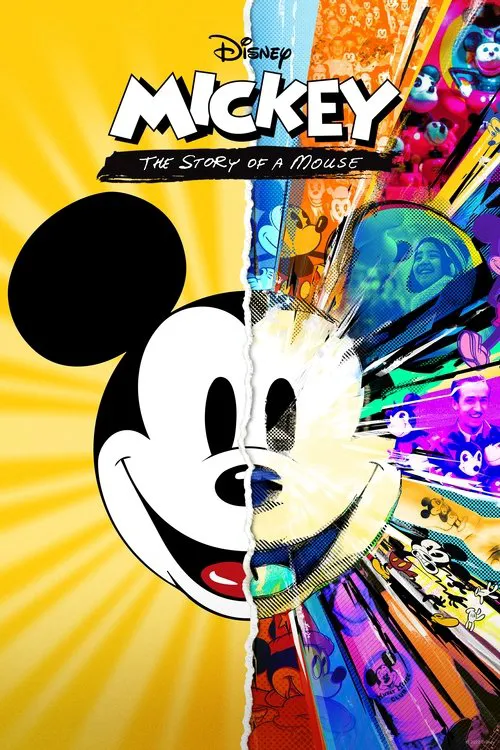Mickey: The Story of a Mouse

Plot
Mickey: The Story of a Mouse is a nostalgic and thought-provoking documentary that delves into the enduring legacy of the world's most beloved rodent, Mickey Mouse. Created by Walt Disney and Ub Iwerks in 1928, Mickey was initially conceived as a replacement for another character, Oswald the Lucky Rabbit. However, Oswald's rights were owned by Universal Pictures, and when Universal threatened to take Oswald away from Disney, Walt Disney created Mickey Mouse as a new character. Mickey made his debut in the cartoon short "Steamboat Willie" and quickly gained popularity for his endearing personality, charming appearance, and signature voice. Throughout the documentary, we're taken on a journey through Mickey's history, from his humble beginnings in the Roaring Twenties to his current status as a global icon. We see early cartoons featuring Mickey in various forms, from his earliest incarnations as a mischievous troublemaker to his later roles as a kind and generous hero. We're shown how Mickey's character evolved over the years, reflecting the changing values and mores of society. In the 1930s, Mickey began to embody the ideals of the American Dream, symbolizing optimism, hard work, and determination. In the 1940s and 1950s, during World War II, Mickey's character became a symbol of American solidarity, with Mickey donning a military uniform and serving as a morale booster for troops and civilians alike. One of the documentary's key themes is the relationship between Mickey and his creator, Walt Disney. Disney's vision for Mickey as a symbol of American culture and values is explored in depth, and we learn how Mickey became an integral part of Disney's strategy to build a family-friendly empire. We're shown how Disney's personal experiences and values shaped Mickey's character, as well as the company's business model. As the documentary notes, Disney's decision to create Mickey as a global icon was a masterstroke, allowing the company to tap into the worldwide appetite for entertainment and escapism. As the documentary progresses, we're also introduced to the many artists, animators, and voice actors who have contributed to Mickey's enduring legacy. From Ub Iwerks to Walt Disney himself, to later artists like animator and director, Ron Clements, each contributor shares their perspective on Mickey's significance and impact. We see early animation techniques and the painstaking process of creating each Mickey short, as well as the evolution of animation technology over the years. The documentary also explores the complex and sometimes fraught history of Disney's treatment of its employees, including animators who were pushed to create iconic images by demanding deadlines and meager pay. This darker aspect of Disney's legacy is skillfully woven into the narrative, highlighting the tension between artistic vision and commercial success. One of the most compelling aspects of the documentary is its exploration of Mickey's cultural significance and impact on modern society. Mickey's ability to transcend culture and geography, to become a symbol that speaks to people from all walks of life, is a fascinating topic of discussion. We see how Mickey has been used as a tool for social commentary, with cartoons like "Fantasia" (1940) and "Dumbo" (1941) using Mickey to explore complex themes like prejudice, class, and the nature of society. The documentary also examines the ways in which Mickey's character has been reimagined over the years, from the 1950s' "Mickey Mouse Club" television show to modern interpretations like Mickey's starring role in the film "Mickey and the Beanstalk" (1947). Throughout the documentary, interviews with historians, critics, and cultural commentators offer nuanced insights into Mickey's significance and cultural impact. We're treated to perspectives from renowned critics, film historians, and artists, as well as everyday people who share their own personal experiences and feelings about Mickey. From nostalgic fans who have grown up with Mickey to cultural critics who see Mickey as a symbol of late capitalism and conformity, the documentary presents a rich tapestry of views and opinions. Ultimately, "Mickey: The Story of a Mouse" is a captivating and thought-provoking exploration of a cultural icon who has become an integral part of our shared identity. As the documentary so astutely observes, Mickey's significance extends far beyond the world of animation and entertainment to tap into something deeper and more profound. Through Mickey, we see the values, aspirations, and fears of a society in flux, reflected back at us like a mirror. As we watch Mickey Mouse navigate the ups and downs of life, we're reminded of our own hopes, dreams, and imperfections – and in doing so, Mickey transcends the boundaries of entertainment to become something far more meaningful: a shared experience that connects us all.
Reviews
Camille
"A quintessential love story, starring a mouse."
Recommendations




